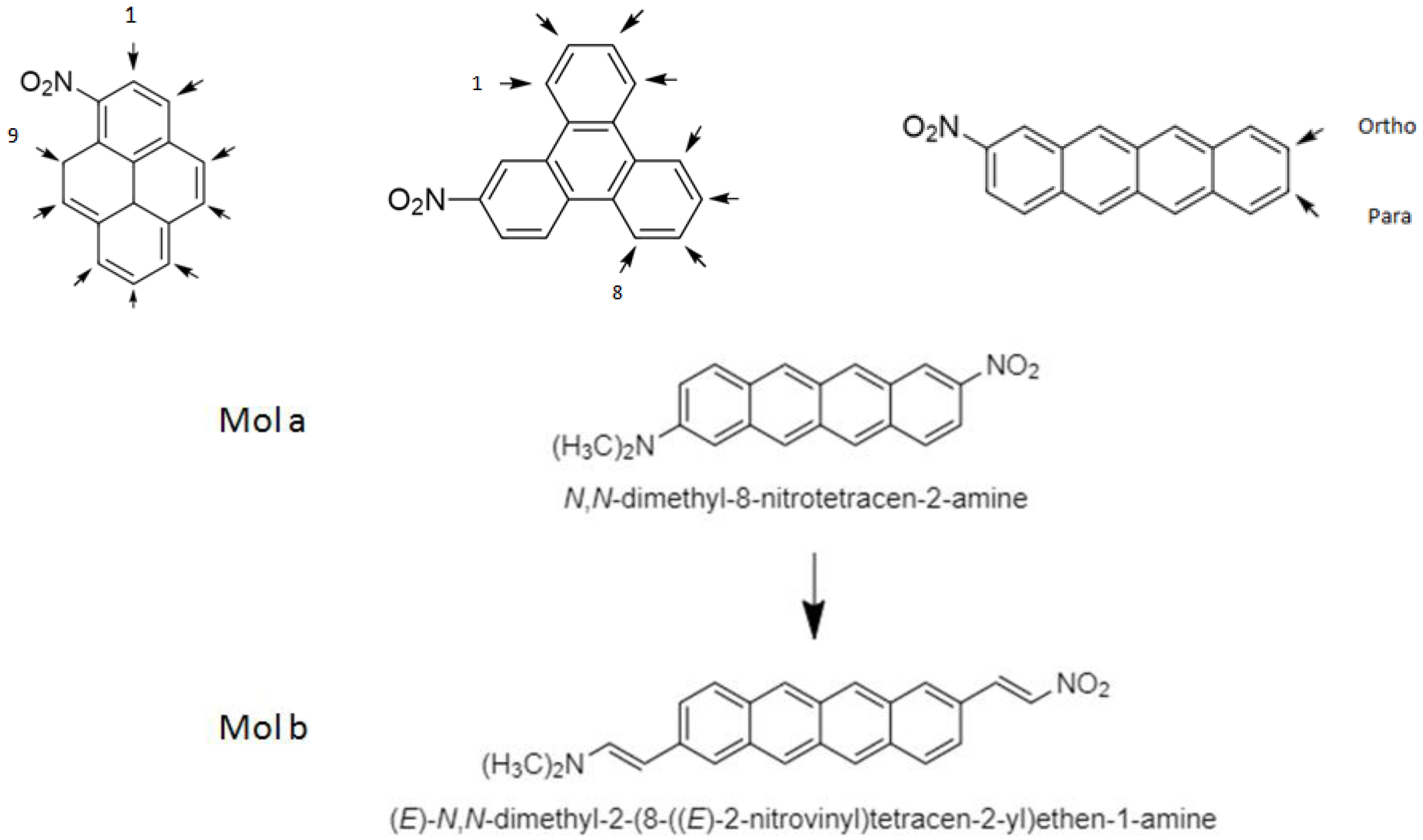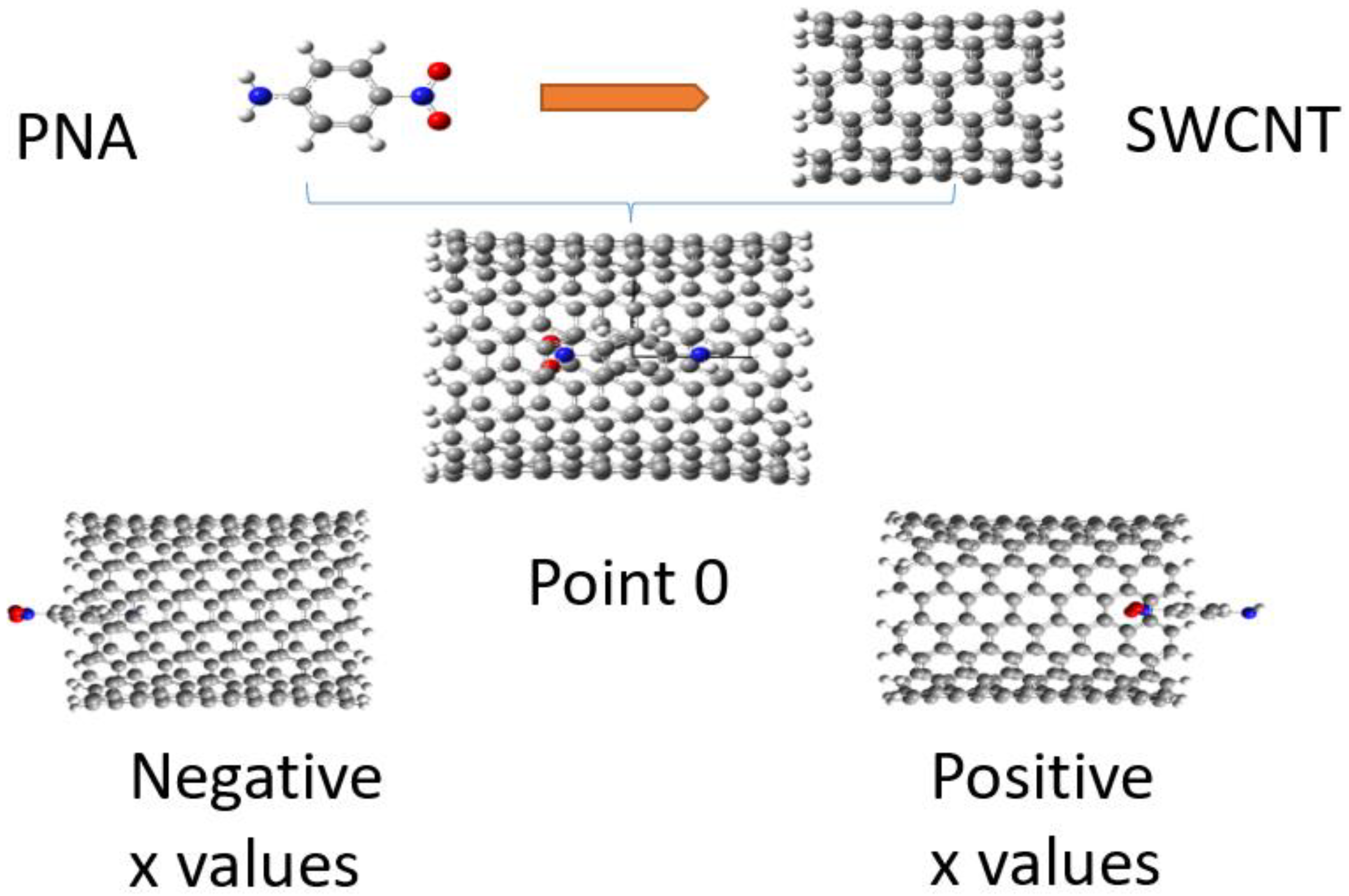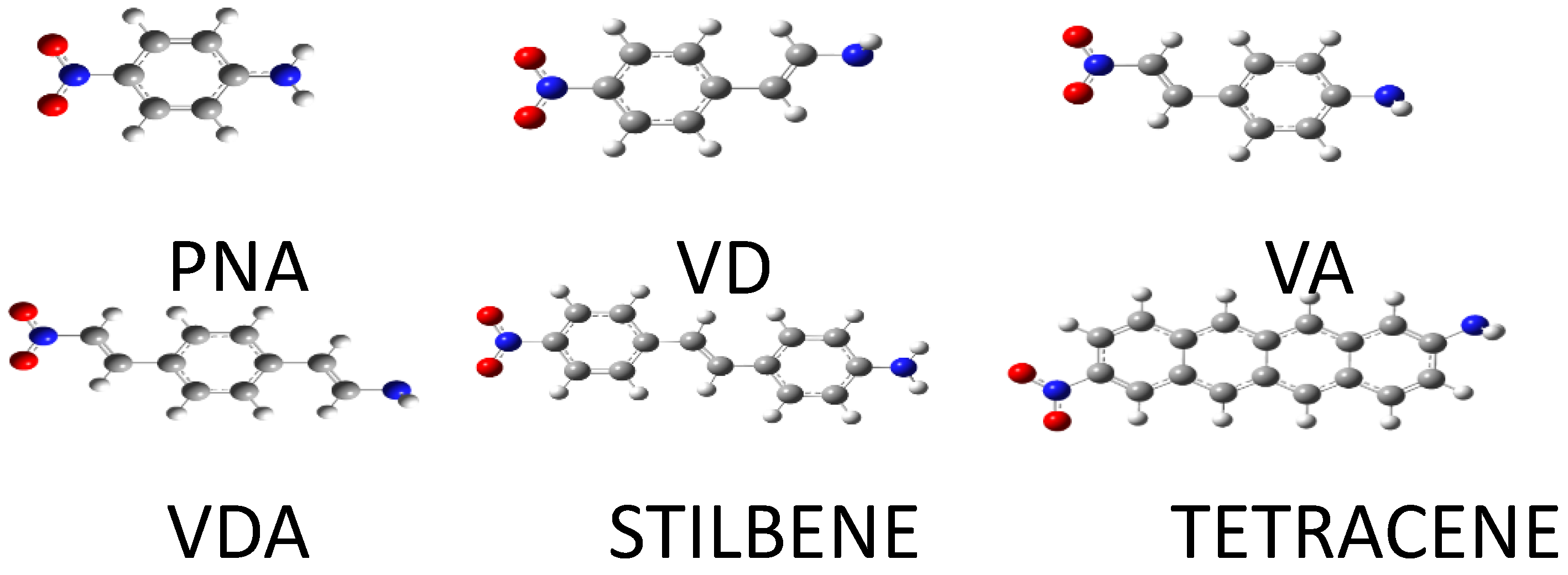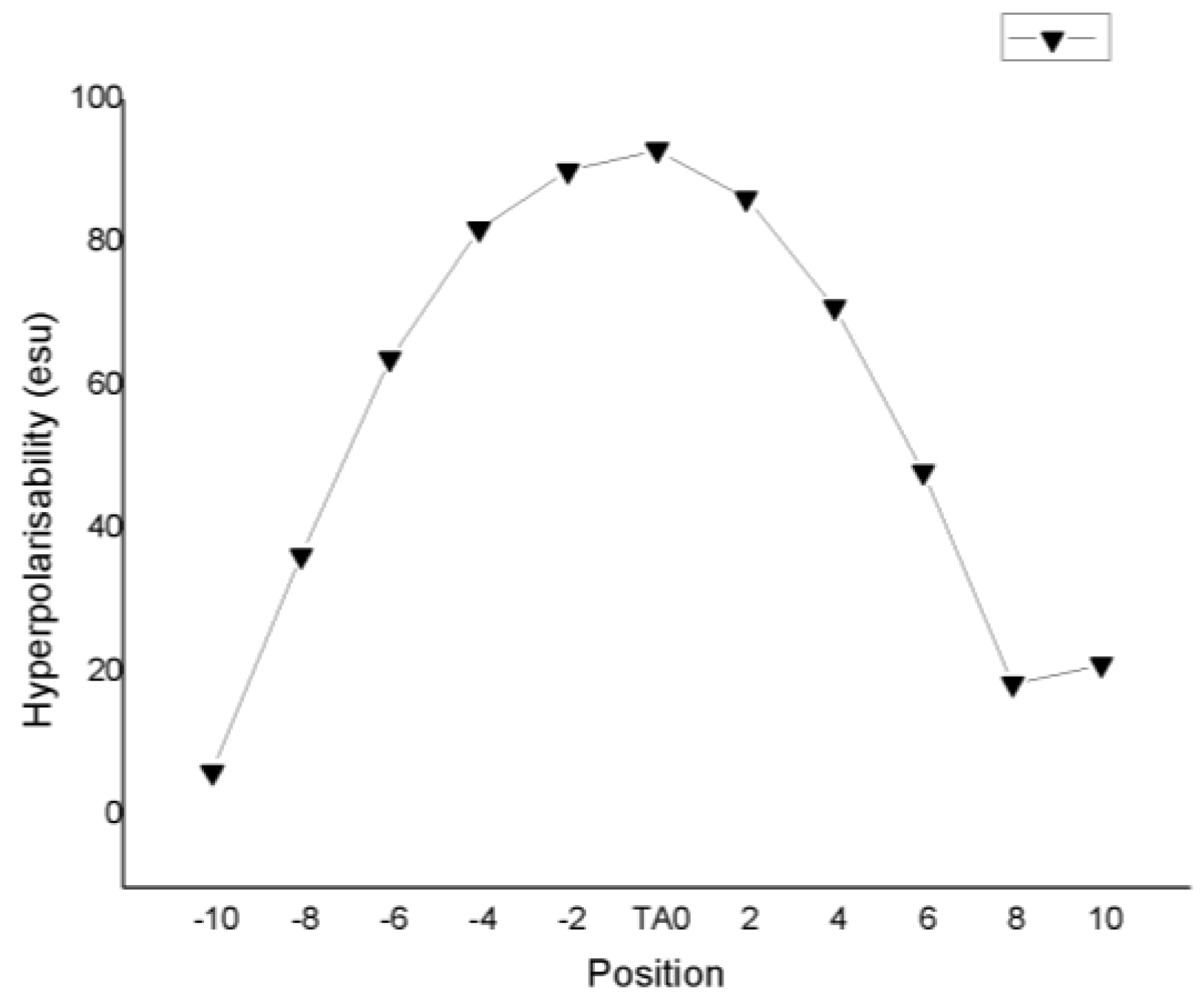Theoretical Study on Non-Linear Optics Properties of Polycyclic Aromatic Hydrocarbons and the Effect of Their Intercalation with Carbon Nanotubes
Abstract
1. Introduction
2. Computational Details
3. Results and Discussion
3.1. I-NLO Responses of PAHs
3.1.1. Ia. Selection of the Functional
3.1.2. Ib. Study of Intramolecular Charge Transfer
3.2. II-Intercalation inside SWCNTs
3.2.1. IIa. Effect of Position
3.2.2. IIb. Effect of the Nature of the Guest Molecule
3.2.3. IIc. Effects due to Substitution
4. Conclusions
Author Contributions
Funding
Institutional Review Board Statement
Informed Consent Statement
Data Availability Statement
Conflicts of Interest
References
- Young, D.; Douglas, K.M.; Eiceman, G.A.; Lake, D.A.; Johnston, M.V. Laser desorption–ionization of polycyclic aromatic hydrocarbons from glass surfaces with ion mobility spectrometry analysis. Anal. Chim. Acta 2002, 453, 231–243. [Google Scholar] [CrossRef]
- Ravindra, K.; Sokhi, R.; Grieken, R.V. Atmospheric polycyclic aromatic hydrocarbons: Source attribution, emission factors and regulation. Atmos. Environ. 2008, 42, 2895–2921. [Google Scholar] [CrossRef]
- Alajtal, A.I.; Edwards, H.G.M.; Elbagerma, M.A.; Scowen, I.J. The effect of laser wavelength on the Raman Spectra of phenanthrene, chrysene, and tetracene: Implications for extra-terrestrial detection of polyaromatic hydrocarbons. Spectrochim. Acta Part A 2010, 76, 1–5. [Google Scholar] [CrossRef] [PubMed]
- Feng, X.; Pisula, W.; Müllen, K. Large polycyclic aromatic hydrocarbons: Synthesis and discotic organization. Pure Appl. Chem. 2009, 81, 2203–2224. [Google Scholar] [CrossRef]
- Arey, J.; Atkinson, R. Photochemical Reactions of PAHs in the Atmosphere. In PAHs: An Ecotoxicological Perspective; Douben, P.E.T., Ed.; John Wiley & Sons, Ltd.: Chichester, UK, 2003. [Google Scholar]
- Lima, A.L.C.; Farrington, J.W.; Reddy, C.M. Combustion-Derived Polycyclic Aromatic Hydrocarbons in the Environment—A Review. Environ. Forensics 2005, 6, 109–131. [Google Scholar] [CrossRef]
- Du, J.; Jing, C. Preparation of Thiol Modified Fe3O4@Ag Magnetic SERS Probe for PAHs Detection and Identification. J. Phys. Chem. C 2011, 115, 17829–17835. [Google Scholar] [CrossRef]
- Broniatowski, M.; Binczycka, M.; Wójcik, A.; Flasiński, M.; Wydro, P. Polycyclic aromatic hydrocarbons in model bacterial membranes–Langmuir monolayer studies. BBA-Biomembranes 2017, 1859, 2402–2412. [Google Scholar] [CrossRef]
- Abdel-Shafy, H.I.; Mansour, M.S.M. A review on polycyclic aromatic hydrocarbons: Source, environmental impact, effect on human health and remediation. Egypt. J. Pet. 2016, 25, 107–123. [Google Scholar] [CrossRef]
- Bayn, A.; Feng, X.; Müllen, K.; Haick, H. Field Effect Transistors Based on Polycyclic Aromatic Hydrocarbons for the Detection and Classification of Volatile Organic Compounds. ACS Appl. Mater. Interfaces 2013, 5, 3431–3440. [Google Scholar] [CrossRef]
- Chien, C.; Lin, C.; Watanabe, M.; Lin, Y.; Chao, T.; Chiang, T.; Huang, X.; Wen, Y.; Tu, C.; Sun, C.; et al. Tetracene-based field-effect transistors using solution processes. J. Mater. Chem. 2012, 22, 13070–13075. [Google Scholar] [CrossRef]
- Wünsche, J.; Tarabella, G.; Bertolazzi, S.; Bocoum, M.; Coppedè, N.; Barba, L.; Arrighetti, G.; Lutterotti, L.; Iannotta, S.; Cicoira, F.; et al. The correlation between gate dielectric, film growth, and charge transport in organic thin film transistors: The case of vacuum-sublimed tetracene thin films. J. Mater. Chem. C 2013, 1, 967–976. [Google Scholar] [CrossRef]
- Hashimoto, S.; Ikuta, T.; Shiren, K.; Nakatsuka, S.; Ni, J.; Nakamura, M.; Hatakeyama, T. Triplet-Energy Control of Polycyclic Aromatic Hydrocarbons by BN Replacement: Development of Ambipolar Host Materials for Phosphorescent Organic Light-Emitting Diodes. Chem. Mater. 2014, 26, 6265–6271. [Google Scholar] [CrossRef]
- Abd-El-Aziza, A.S.; Dalgakiran, S.; Kucukkaya, I.; Wagner, B.D. Synthesis, electrochemistry and fluorescence behavior of thiophene derivatives decorated with coumarin, pyrene and naphthalene moieties. Electrochim. Acta 2013, 89, 445–453. [Google Scholar] [CrossRef]
- Wang, G.; Huang, B.; Liu, D.; Zheng, D.; Harris, J.; Xue, J.; Qu, D. Exploring polycyclic aromatic hydrocarbons as an anolyte for nonaqueous redox flow batteries. J. Mater. Chem. A 2018, 6, 13286–13293. [Google Scholar] [CrossRef]
- Anne, F.B.; Purpan, F.D.; Jacquemin, D. Charge-Transfer in Quasilinear Push-Pull Polyene Chains. Chem. Phys. Lett. 2013, 581, 52–56. [Google Scholar] [CrossRef]
- Derrar, S.N.; Sekkal-Rahal, M.; Derreumaux, P.; Springborg, M. Theoretical study of the NLO responses of some natural and unnatural amino acids used as probe molecules. J. Mol. Model. 2014, 20, 2388. [Google Scholar] [CrossRef]
- Derrar, S.N.; Sekkal-Rahal, M.; Guemra, K.; Derreumaux, P. Theoretical study on a series of push–pull molecules grafted on methacrylate copolymers serving for nonlinear optics. Int. J. Quantum Chem. 2012, 112, 2735–2742. [Google Scholar] [CrossRef]
- Wang, S.; Kim, S. Photophysical and electrochemical properties of D–π–A type solvatofluorchromic isophorone dye for pH molecular switch. Curr. Appl. Phys. 2009, 9, 783–787. [Google Scholar] [CrossRef]
- Kleinpeter, E.; Stamboliyska, B.A. Hyperpolarizability of donor–acceptor azines subject to push–pull character and steric hindrance. Tetrahedron 2009, 65, 9211–9217. [Google Scholar] [CrossRef]
- Tang, X. Theoretical study on electron structure and charge transportproperties of tetraazapentacene derivatives. J. Mol. Graph. Model. 2017, 76, 535–542. [Google Scholar] [CrossRef]
- Malloci, G.; Mulas, G.; Cappellini, G.; Fiorentini, V.; Porceddu, I. Theoretical electron affinities of PAHs and electronic absorption spectra of their mono-anions. Astron. Astrophys. 2005, 432, 585–594. [Google Scholar] [CrossRef]
- Cardia, R.; Malloci, G.; Bosin, A.; Serra, G.; Cappellini, G. Computational investigation of the effects of perfluorination on the charge-transport properties of polyaromatic hydrocarbons. Chem. Phys. 2016, 478, 8–13. [Google Scholar] [CrossRef]
- Chai, S.; Huang, J. Impact of the halogenated substituent on electronic and charge transport properties of organic semiconductors: A theoretical study. Comput. Theor. Chem. 2015, 1069, 48–55. [Google Scholar] [CrossRef]
- Sancho-García, J.C.; Pérez-Jiménez, A.J. A theoretical study of p-stacking tetracene derivatives as promising organic molecular semiconductors. Chem. Phys. Lett. 2010, 499, 146–151. [Google Scholar] [CrossRef]
- Ghosh, D.; Periyasamy, G.; Pati, S.K. Density functional theoretical investigation of the aromatic nature of BN substituted benzene and four ring polyaromatic hydrocarbons. Phys. Chem. Chem. Phys. 2011, 13, 20627–20636. [Google Scholar] [CrossRef] [PubMed]
- Iijima, S. Helical microtubules of graphitic carbon. Nature 1991, 354, 56–58. [Google Scholar] [CrossRef]
- Dai, H. Carbon Nanotubes: Synthesis, Integration, and Properties. Acc. Chem. Res. 2002, 35, 1035–1044. [Google Scholar] [CrossRef]
- Maniecki, T.; Shtyka, O.; Mierczynski, P.; Ciesielski, R.; Czylkowska, A.; Leyko, J.; Mitukiewicz, G.; Dubkov, S.; Gromov, D. Carbon nanotubes: Properties, synthesis, and application. Fibre Chem. 2018, 50, 297–300. [Google Scholar] [CrossRef]
- Popov, V.N. Carbon nanotubes: Properties and application. Mater. Sci. Eng. 2004, 43, 61–102. [Google Scholar] [CrossRef]
- Seidel, R.; Graham, A.P.; Unger, E.; Duesberg, G.S.; Liebau, M.; Steinhoegl, W.; Kreupl, F.; Hoenlein, W. High-Current Nanotube Transistors. Nano Lett. 2004, 4, 831–834. [Google Scholar] [CrossRef]
- Khazaei, A.; Soltani Rad, M.N.; Kiani Borazjani, M. Organic functionalization of single-walled carbon nanotubes (SWCNTs) with some chemotherapeutic agents as a potential method for drug delivery. Int. J. Nanomed. 2010, 5, 639–645. [Google Scholar] [CrossRef] [PubMed]
- Hirscher, M.; Becher, M.; Haluska, M.; Quintel, A.; Skakalova, V.; Choi, Y.-M.; Dettlaff-Weglikowska, U.; Roth, S.; Stepanek, I.; Bernier, P.; et al. Hydrogen storage in carbon nanostructures. J. Alloys Compd. 2002, 330, 654–658. [Google Scholar] [CrossRef]
- Chaban, V.V.; Prezhdo, V.V.; Oleg Prezhdo, V. Covalent Linking Greatly Enhances Photoinduced Electron Transfer in Fullerene-Quantum Dot Nanocomposites: Time-Domain Ab Initio Study. J. Phys. Chem. Lett. 2013, 4, 1–6. [Google Scholar] [CrossRef] [PubMed]
- Chaban, V.V.; Pal, S.; Prezhdo, O.V. Laser-Induced Explosion of Nitrated Carbon Nanotubes: Non-Adiabatic and Reactive Molecular Dynamics Simulations. J. Am. Chem. Soc. 2016, 138, 15927–15934. [Google Scholar] [CrossRef] [PubMed]
- Deb, J.; Paul, D.; Sarkar, U. Density Functional Theory Investigation of Nonlinear Optical Properties of T-Graphene Quantum Dots. J. Phys. Chem. A 2020, 124, 1312–1320. [Google Scholar] [CrossRef]
- Ayoubikaskooli, A.; Ghaedi, A.M.; Shamlouei, H.R.; Saghapour, Y. Influence of donor–acceptor groups on the electrical and optical properties of C50 fullerene. J. Mol. Model. 2022, 28, 7. [Google Scholar] [CrossRef]
- Carlotti, B.; Benassi, E.; Barone, V.; Consiglio, G.; Elisei, F.; Mazzoli, A.; Spalletti, A. Effect of the π Bridge and Acceptor on Intramolecular Charge Transfer in Push–Pull Cationic Chromophores: An Ultrafast Spectroscopic and TD-DFT Computational Study. Chem. Phys. Chem. 2015, 16, 1440–1450. [Google Scholar] [CrossRef]
- Yong Lee, J.; Kim, K.S.; Mhin, B.J. Intramolecular charge transfer of π-conjugated push–pull systems in terms of polarizability and electronegativity. J. Chem. Phys. 2001, 115, 9484–9489. [Google Scholar] [CrossRef]
- Plaquet, A.; Champagne, B.; Kulhanek, J.; Bures, F.; Bogdan, E.; Castet, F.; Ducasse, L.; Rodriguez, V. Effects of the nature and length of the π-conjugated bridge on the second-order nonlinear optical responses of push–pull molecules including 4,5 dicyanoimidazole and their protonated forms. Chem. Phys. Chem. 2011, 12, 3245–3252. [Google Scholar] [CrossRef]
- Makwani, D.; Vijaya, R. Frequency-dependent hyperpolarizability of benzene derivatives: Ab-initio calculations. J. Nonlinear Opt. Phys. Mater. 2007, 16, 367–380. [Google Scholar] [CrossRef]
- Albert, I.D.L.; Marks, T.J.; Ratner, M.A. Large Molecular Hyperpolarizabilities. Quantitative Analysis of Aromaticity and Auxiliary Donor-Acceptor Effects. J. Am. Chem. Soc. 1997, 119, 6575–6582. [Google Scholar] [CrossRef]
- Khan, M.S.A. Srivastava. NH3 and NO2 adsorption analysis of GaN nanotube: A First principle Investigation. J. Electroanal. Chem. 2016, 775, 243–250. [Google Scholar] [CrossRef]
- Naderi, S.; Morsali, A.; Bozorgmehr, M.R.; Beyramabadi, S.A. Mechanistic energetic and structural studies of carbon nanotubes functionalised with dihydroartemisinin drug in gas and solution phases. Phys. Chem. Liq. 2017, 56, 610–618. [Google Scholar] [CrossRef]
- Smith, D.G.A.; Burns, L.A.; Patkowski, K.; Sherrill, C.D. Revised Damping Parameters for the D3 Dispersion Correction to Density Functional Theory. J. Phys. Chem. Lett. 2016, 7, 2197–2203. [Google Scholar] [CrossRef] [PubMed]
- Silva, D.A.; Xavier, M.J.; Dutra, J.D.L.; Gimenez, I.D.F.; Freire, R.O.; da Costa, N.B., Jr. Prediction of correct intermolecular interactions in host-guest systems involving cyc Lodextrins. J. Mol. Struct. 2020, 1205, 127517. [Google Scholar] [CrossRef]
- Dennington, R.; Keith, T.; Millam, J. Gaussview 05; Semichem, Inc.: Shawnee Mission, KS, USA, 2009; Volume 330–332, pp. 654–658. [Google Scholar]
- Frisch, M.J.; Trucks, G.W.; Schlegel, H.B.; Scuseria, G.E.; Robb, M.A.; Cheeseman, J.R.; Scalmani, G.; Barone, V.; Petersson, G.A.; Nakatsuji, H.; et al. Gaussian 09; Gaussian, Inc.: Wallingford, CT, USA, 2009. [Google Scholar]
- Fulem, M.; Laštovka, V.; Straka, M.; Ružiĉka, K.; Shaw, J.M. Heat Capacities of Tetracene and Pentacene. J. Chem. Eng. Data 2008, 53, 2175–2181. [Google Scholar] [CrossRef]
- Khudhaira, A.M.; Ajeela, F.N.; Mohammed, M.H. Theoretical (DFT and TDDFT) insights into the effect of polycyclic aromatic hydrocarbons on Monascus pigments and its implication as a photosensitizer for dye-sensitized solar cells. Microelectron. Eng. 2019, 212, 21–26. [Google Scholar] [CrossRef]
- Betowski, L.D.; Enlow, M.; Riddick, L.; Aue, D.H. Calculation of electron affinities of polycyclic aromatic hydrocarbons and solvation energies of their radical anion. J. Phys. Chem. A 2006, 110, 12927–12946. [Google Scholar] [CrossRef]
- Zouaoui-Rabah, M.; Sekkal-Rahal, M.; Djilani-Kobibi, F.; Elhorri, A.M.; Springborg, M. Performance of hybrid dft compared to mp2 methods in calculating nonlinear optical properties of divinylpyrene derivative molecules. J. Phys. Chem. A 2016, 120, 8843–8852. [Google Scholar] [CrossRef]
- Kubas, A.; Gajdos, F.; Heck, A.; Oberhofer, H.; Elstner, M.; Blumberger, J. Electronic couplings for molecular charge transfer: Benchmarking CDFT, FODFT and FODFTB against high-level ab initio calculations. Phys. Chem. Chem. Phys. 2015, 17, 14342–14354. [Google Scholar] [CrossRef]
- Ari, H.; Büyükmumcu, Z. Comparison of DFT functionals for prediction of band gap of conjugated polymers and effect of HF exchange term percentage and basis set on the performance. Comput. Mater. Sci. 2017, 138, 70–76. [Google Scholar] [CrossRef]
- Cohen, A.J.; Handy, N.C. Assessment of exchange correlation functional. Chem. Phys. Lett. 2000, 316, 160–166. [Google Scholar] [CrossRef]
- Peach, M.J.G.; Tellgren, E.I.; Sałek, P.; Helgaker, T.; Tozer, D.J. structural and electronic properties of polyacetylene and polyyne from hybrid and coulomb-attenuated density functionals. J. Phys. Chem. A 2007, 111, 11930–11935. [Google Scholar] [CrossRef] [PubMed]
- McKechnie, S.; Booth, G.H.; Cohen, A.J.; Cole, J.M. On the accuracy of density functional theory and wave function methods for calculating vertical ionization energies. J. Chem. Phys. 2015, 142, 194114. [Google Scholar] [CrossRef]
- Mardirossian, N.; Head-Gordon, M. Thirty years of density functional theory in computational chemistry: An overview and extensive assessment of 200 density functionals. Mol. Phys. 2017, 115, 2315–2372. [Google Scholar] [CrossRef]
- Daniel Boese, A.; Martin, J.M.L. Development of density functionals for thermochemical kinetics. J. Chem. Phys. 2004, 121, 3405–3416. [Google Scholar] [CrossRef] [PubMed]
- Marcano, E.; Squitieri, E.; Murgich, J.; Soscún, H. Theoretical investigation of the static (dynamic) polarizability and second hyperpolarizability of DAAD quadrupolar push–pull molecules. A comparison among HF (TD-HF), DFT (TD-B3LYP), and MP2 (TD-MP2) methods. Comput. Theor. Chem. 2012, 985, 72–79. [Google Scholar] [CrossRef]
- Karamanis, P.; Maroulis, G. Static electric dipole polarizability and hyperpolarizability of fluorodiacetylene. J. Mol. Struct. 2003, 621, 157–162. [Google Scholar] [CrossRef]
- Capobianco, A.; Centore, R.; Noce, C.; Peluso, A. Molecular hyperpolarizabilities of push–pull chromophores: A comparison between theoretical and experimental results. Chem. Phys. 2013, 411, 11–16. [Google Scholar] [CrossRef]
- Fonseca, T.L.; de Oliveira, H.C.B.; Amaral, O.A.V.; Castro, M.A. MP2 static first hyperpolarizability of azo-enaminone isomers. Chem. Phys. Lett. 2005, 413, 356–361. [Google Scholar] [CrossRef]
- Champagne, B.; Perpète, E.A.; Jacquemin, D. Assessment of Conventional Density Functional Schemes for Computing the Dipole Moment and (Hyper)polarizabilities of Push-Pull π-Conjugated Systems. J. Phys. Chem. A 2000, 104, 4755–4763. [Google Scholar] [CrossRef]
- Günay, N.; Pir, H.; Avcı, D.; Atalay, Y. NLO and NBO Analysis of Sarcosine-Maleic Acid by Using HF and B3LYP Calculations. J. Chem. 2013, 16, 712130. [Google Scholar] [CrossRef]
- Heesink, G.J.T.; Ruiter, A.G.T.; van Hulst, N.F.; Bolger, B. Determination of Hyperpolarizability Tensor Components by Depolarized Hyper Rayleigh Scattering. Phys. Rev. Lett. 1993, 71, 999–1002. [Google Scholar] [CrossRef]
- Labidi, N.S. Semi empirical and Ab initio methods for calculation of polarizability (α) and the hyperpolarizability (β) of substituted polyacetylene chain. Arab. J. Chem. 2016, 9, S1252–S1259. [Google Scholar] [CrossRef]
- Limacher, P.A.; Mikkelsen, K.V.; Lüthi, H.P. On the accurate calculation of polarizabilities and second hyperpolarizabilities of polyacetylene oligomer chains using the CAMB3LYP density functional. J. Chem. Phys. 2009, 130, 194114. [Google Scholar] [CrossRef] [PubMed]
- Yanai, T.; Tew, D.P.; Handy, N.C. A new hybrid exchange–correlation functional using the Coulomb-attenuating method (CAM-B3LYP). Chem. Phys. Lett. 2004, 393, 51–57. [Google Scholar] [CrossRef]
- Ma, N.N.; Yang, G.C.; Sun, S.L.; Liu, C.G.; Qiu, Y.Q. Computational study on second-order nonlinear optical (NLO) properties of a novel class of two-dimensional Λ- and W-shaped sandwich metallocarborane-containing chromophores. J. Organomet. Chem. 2011, 696, 2380–2387. [Google Scholar] [CrossRef]
- Kirtman, B.; Champagne, B.; Bishop, D.M. Electric Field Simulation of Substituents in Donor-Acceptor Polyenes: A Comparison with Ab Initio Predictions for Dipole Moments, Polarizabilities, and Hyperpolarizabilities. J. Am. Chem. Soc. 2000, 122, 8007–8012. [Google Scholar] [CrossRef]
- Winkler, R.; Pantelides, S.T. Charge transfer and dipole moments of polyatomic systems. J. Chem. Phys. 1997, 106, 7714–7719. [Google Scholar] [CrossRef]
- Del Zoppo, M.; Castiglioni, C.; Gerola, V.; Zuliani, P.; Zerbi, G. Effect of bond length alternation and of bond length alternation oscillations on the molecular nonlinear optical response of push–pull polyenes. J. Opt. Soc. Am. 1998, 15, 1. [Google Scholar] [CrossRef]
- Benchehaima, F.Z.; Springborg, M.; Sekkal Rahal, M. Nonlinear optical properties DFT calculations of polyacethylene and copolymers models substituted with aldimines chromophores as side chains. J. Comput. Chem. 2022, 43, 1701–1718. [Google Scholar] [CrossRef] [PubMed]
- Thanthiriwatte, K.S.; de Silva, K.M.N. Non-linear optical properties of novel fluorenyl derivatives—Ab initio quantum chemical calculations. J. Mol. Struct. 2002, 617, 169–175. [Google Scholar] [CrossRef]






| NH2 -O | NH2 -P | N(CH3)2 -O | N(CH3)2 -P | OH -O | OH -P | OCH3 -O | OCH3 -P | N2H3 -O | N2H3 -P | |
|---|---|---|---|---|---|---|---|---|---|---|
| BMK | 46.71 | 34.64 | 65.77 | 11.01 | 35.68 | 49.82 | 40.66 | 58.78 | 54.94 | 84.75 |
| BHHLYP | 41.89 | 32.22 | 56.49 | 92.62 | 32.58 | 44.90 | 36.40 | 51.62 | 48.09 | 73.02 |
| CAM-B3LYP | 39.95 | 28.55 | 54.45 | 85.07 | 30.62 | 41.38 | 34.52 | 47.83 | 46.31 | 67.71 |
| PBE0 | 84.29 | 67.14 | 120.27 | 235.47 | 67.49 | 104.58 | 78.81 | 129.36 | 100.44 | 179.01 |
| M06-2X | 40.68 | 28.25 | 57.43 | 25.78 | 30.28 | 41.22 | 34.49 | 48.14 | 47.84 | 70.89 |
| MP2 | 45.65 | 29.78 | 63.76 | 91.29 | 34.06 | 42.51 | 38.57 | 49.16 | 52.83 | 71.22 |
| NH2-O | NH2-P | N(CH3)2-O | N(CH3)2-P | OH-O | OH-P | OCH3-O | OCH3-P | N2H3-O | N2H3-P | |
|---|---|---|---|---|---|---|---|---|---|---|
| βx | 39.89 | −28.52 | 54.42 | −85.01 | 30.60 | 41.29 | 34.52 | 47.78 | 46.28 | −67.63 |
| βy | 2.06 | −1.41 | 1.63 | −3.02 | 0.93 | −2.61 | 0.38 | −2.30 | 1.13 | −3.12 |
| βz | 0.68 | 0.01 | −0.62 | −0.49 | 0.00 | 0.00 | 0.00 | 0.00 | −1.05 | −1.12 |
| βtot | 39.95 | 28.55 | 54.45 | 85.07 | 30.61 | 41.38 | 34.52 | 47.83 | 46.31 | 67.71 |
| µtot | 8.34 | 6.53 | 9.21 | 9.72 | 7.68 | 7.53 | 7.02 | 7.62 | 9.19 | 10.07 |
| gap | 4.61 | 4.76 | 4.50 | 4.50 | 4.66 | 4.68 | 4.60 | 4.62 | 4.58 | 4.61 |
| mol 1 | mol 2 | mol 3 | mol 4 | mol 5 | mol 6 | mol 7 | mol 8 | |
|---|---|---|---|---|---|---|---|---|
| βx | −8.53 | −4.81 | −9.17 | 10.17 | −9.91 | 13.21 | 9.65 | −7.32 |
| βy | −1.15 | −7.96 | −6.66 | −4.72 | −0.38 | −3.05 | −4.28 | −4.05 |
| βz | 0.00 | 0.00 | 0.00 | 0.00 | 0.00 | 0.00 | 0.00 | 0.00 |
| βtot | 8.60 | 9.29 | 11.32 | 11.21 | 9.91 | 13.55 | 10.55 | 8.36 |
| µtot | 5.10 | 4.81 | 8.14 | 7.23 | 7.85 | 5.63 | 7.27 | 7.10 |
| gap | 6.48 | 6.34 | 6.35 | 6.38 | 6.33 | 6.39 | 6.33 | 6.40 |
| mol 1-3 | mol 1-4 | mol 1-5 | mol 1-6 | mol 1-7 | mol 1-8 | mol 1-9 | |
|---|---|---|---|---|---|---|---|
| βx | 3.83 | −10.94 | −19.48 | −22.99 | 19.08 | 19.04 | −10.89 |
| βy | 9.42 | −1.18 | 0.79 | 2.69 | −1.44 | −1.09 | −1.79 |
| βz | 0.60 | 0.29 | 0.67 | 0.75 | 0.43 | 0.59 | 0.15 |
| βtot | 10.18 | 11.01 | 19.50 | 23.16 | 19.14 | 19.08 | 11.03 |
| µtot | 4.92 | 5.91 | 6.65 | 6.89 | 7.62 | 6.20 | 5.02 |
| gap | 5.26 | 5.42 | 5.48 | 5.25 | 5.38 | 5.21 | 5.41 |
| β0 | µ | gap | HOMO | LUMO | |
|---|---|---|---|---|---|
| D-TETR-A | 85.07 | 9.72 | 4.53 | −6.13 | −1.61 |
| D-ISO-A | 13.55 | 5.63 | 6.39 | −7.67 | −1.28 |
| D-PYR-A | 23.16 | 6.89 | 5.25 | −6.75 | −1.50 |
| β0 | µ | HOMO | LUMO | GAP | BLA | |
|---|---|---|---|---|---|---|
| Mol_a | 85.07 | 9.72 | −6.25 | −1.64 | 4.53 | 0.077 |
| Mol_b | 229.79 | 11.31 | −6.14 | −1.72 | 4.34 | 0.086 |
| −10 | −8 | −6 | −4 | −2 | 0 | 2 | 4 | 6 | 8 | 10 | |
|---|---|---|---|---|---|---|---|---|---|---|---|
| βtot | 6.14 | 36.37 | 63.82 | 81.97 | 92.14 | 93.00 | 86.28 | 71.12 | 47.99 | 18.46 | 21.09 |
| µtot | 5.18 | 3.97 | 3.09 | 2.56 | 2.36 | 2.33 | 2.45 | 2.86 | 3.72 | 5.29 | 7.24 |
| gap | 1.85 | 1.85 | 1.85 | 1.85 | 1.85 | 1.85 | 1.85 | 1.85 | 1.85 | 1.85 | 1.85 |
| PNA | STIL | TETR | VA | VD | VDA | |
|---|---|---|---|---|---|---|
| βtot | 93.00 | 89.60 | 68.79 | 78.82 | 72.49 | 114.35 |
| µtot | 2.32 | 3.46 | 2.75 | 2.15 | 1.97 | 3.57 |
| gap | 1.85 | 1.85 | 1.85 | 1.85 | 1.85 | 1.85 |
| TA0 | TA1 | |
|---|---|---|
| βx | −7.92 | 262.94 |
| βy | 0.63 | −101.40 |
| βz | −92.66 | −19.93 |
| βtot | 93.00 | 282.52 |
| µx | −2.31 | 6.78 |
| µy | 0.09 | 5.82 |
| µz | 0.23 | 0.42 |
| µtot | 2.32 | 8.94 |
| Gap | 1.85 | 1.82 |
Disclaimer/Publisher’s Note: The statements, opinions and data contained in all publications are solely those of the individual author(s) and contributor(s) and not of MDPI and/or the editor(s). MDPI and/or the editor(s) disclaim responsibility for any injury to people or property resulting from any ideas, methods, instructions or products referred to in the content. |
© 2022 by the authors. Licensee MDPI, Basel, Switzerland. This article is an open access article distributed under the terms and conditions of the Creative Commons Attribution (CC BY) license (https://creativecommons.org/licenses/by/4.0/).
Share and Cite
Khelladi, I.; Springborg, M.; Rahmouni, A.; Chadli, R.; Sekkal-Rahal, M. Theoretical Study on Non-Linear Optics Properties of Polycyclic Aromatic Hydrocarbons and the Effect of Their Intercalation with Carbon Nanotubes. Molecules 2023, 28, 110. https://doi.org/10.3390/molecules28010110
Khelladi I, Springborg M, Rahmouni A, Chadli R, Sekkal-Rahal M. Theoretical Study on Non-Linear Optics Properties of Polycyclic Aromatic Hydrocarbons and the Effect of Their Intercalation with Carbon Nanotubes. Molecules. 2023; 28(1):110. https://doi.org/10.3390/molecules28010110
Chicago/Turabian StyleKhelladi, Imane, Michael Springborg, Ali Rahmouni, Redouane Chadli, and Majda Sekkal-Rahal. 2023. "Theoretical Study on Non-Linear Optics Properties of Polycyclic Aromatic Hydrocarbons and the Effect of Their Intercalation with Carbon Nanotubes" Molecules 28, no. 1: 110. https://doi.org/10.3390/molecules28010110
APA StyleKhelladi, I., Springborg, M., Rahmouni, A., Chadli, R., & Sekkal-Rahal, M. (2023). Theoretical Study on Non-Linear Optics Properties of Polycyclic Aromatic Hydrocarbons and the Effect of Their Intercalation with Carbon Nanotubes. Molecules, 28(1), 110. https://doi.org/10.3390/molecules28010110





